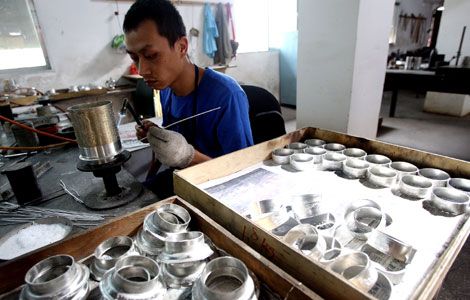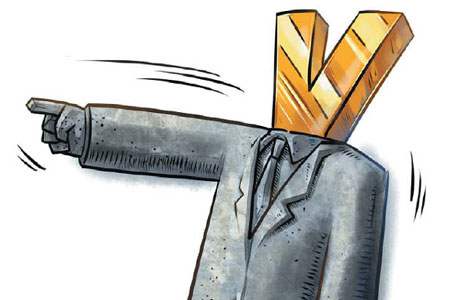Automakers look to drive sales overseas
Updated: 2013-09-03 01:24
By Alfred Romann (China Daily)
|
||||||||
Chinese carmakers will have to rethink strategy, improve products in order to compete globally, reports Alfred Romann in Hong Kong.
More than 1 million new cars were sold in Indonesia last year. That fact alone makes the Southeast Asia giant a very desirable market for automakers.

Indonesia accounts for about 40 percent of the population of the Association of Southeast Asian Nations and its economy has been growing fast, at more than 4 percent a year for more than a decade. It is a natural export market for Chinese auto manufacturers looking to up their market share.
And it gets better.
Earlier this year, the Indonesian government launched new tax incentives for low-cost green cars, which give automakers another reason to get into the action. The government has cut the luxury tax by 25 percent for cars that have a fuel efficiency of 20 kilometers per liter, 50 percent for 28 km per liter and 100 percent for cars that can go even further.
But there is a catch. These vehicles must be assembled domestically and as much as 84 percent of the components must be made locally. Virtually no Chinese automakers are in a position to take advantage of those tax breaks. For the time being, Japanese automakers will continue to dominate the market.
Not only in Indonesia but in most foreign markets, Chinese automakers are having a hard time competing with more advanced multinational manufacturers from Japan, South Korea, Europe and North America.
Chinese companies want to go abroad, but their offerings are still of lower quality and the after-sales service typically weak because they generally do not have the networks in place to provide quality services, said John Zeng, managing director at LMC Automotive Consulting in Shanghai.
Aside from a couple of standouts such as Great Wall Motors Co Ltd, Chery Automobile Co Ltd and possibly Zhejiang Geely Holding Group Co Ltd, most Chinese automakers simply cannot compete in this area.
"(Chinese automakers) are quite eager to go overseas. It is a great marketing tool for them to go overseas. It is good advertising for them,"said Zeng. The problem is that "most of them are treating overseas markets as a trading business. They mainly rely on price as a weapon".
On the surface, it makes sense for Chinese automobile manufacturers to look to new markets.
Competition in China is intensifying and overcapacity among domestic makers is still a significant issue, according to a new report by international consultancy AlixPartners. Most Chinese manufacturers operate at 65 percent capacity, compared with the 80 percent considered to be the minimum for stable profits.
At the same time, Chinese automakers have struggled to gain market share, particularly in the key sedan segment. The only standout is Great Wall, which has a leading position in the China sport utility vehicle market, according to the report. In the luxury car segment, Bayerische Motoren Werke AG (BMW) and Audi AG lead the way, followed by Mercedes-Benz.
Dongfeng Motor Corp, China's second largest auto group, plans to boost sales abroad from 64,000 in 2011 to about 300,000 by 2016.
In October 2012, the Chongqing-based Lifan Industry Group announced plans to invest in its overseas operations to double exports to 120,000 by 2015. If the company meets that target, exports will account for about 40 percent of total sales and jump from around 53,000.
Zhejiang Geely Group, which has owned Volvo Car Corp since 2010, is looking to expand abroad rapidly. The company's exports in 2012 reached 100,000 vehicles, about 20 percent more than originally expected, mostly in Russia, Ukraine, Iraq and Saudi Arabia. By the end of this year, the company aims to export as many as 150,000 units.
"We will do everything in our power to explore overseas markets,"said Beijing Automotive Group Chairman Xu Heyi in a statement. By 2020, the company wants to earn $408 million in profits abroad.
In June, Beijing Auto announced an international strategy that would see the company's annual sales outside China jump to 400,000 vehicles by 2020. More than two-thirds of these cars would also be manufactured abroad.
SAIC Motor Corp acquired MG Motor in 2005. The company has plans to launch a joint venture in Thailand and to make its MG6 sports car and its Maxus commercial vehicles there as well. SAIC is China's largest automaker by sales and revenue.
Chinese passenger vehicle exports peaked in 2008 at 314,000 before halving the following year. They have been climbing steadily since. In 2012, exports jumped to 616,738. The vast majority of these vehicles are going to emerging markets in the Middle East and Africa.
Total vehicle exports last year rose 30 percent to 1.05 million, according to the China Association of Automobile Manufacturers. Chinese automakers have set up 546 companies and institutes abroad with investments approved by the Ministry of Commerce.
The top exporters were Chery, Geely, Great Wall Motors, SAIC Motor and Lifan. In the first half of this year, Chinese automakers exported 486,800 vehicles, a drop of 0.6 percent from last year, according to CAAM.
Zhang Lin, Geely's vice-president, said in a statement that total demand outside China could reach about 20 million vehicles a year, about the same as in China. Geely is another company that is doing a good job both domestically and abroad, according to analysts.
But all this activity amounts to very little volume both in terms of the global auto market and compared with how many units automakers can actually produce.
Chinese manufacturers are operating well below capacity. While the trend among multinational carmakers is to develop manufacturing platforms that can produce multiple models and millions of vehicles, the platforms of Chinese automakers typically produce about 100,000. But because most of them want to do everything, they have multiple expensive platforms.
The end result is that upgrading is expensive. So is setting up manufacturing facilities overseas to produce more cars with low market shares. What's more, it does not make sense to invest hundreds of millions of dollars in a new factory when a pre-existing factory in China has plenty of capacity to pump out more cars.
So manufacturers produce more at home and then try to sell the vehicles through networks of dealers abroad.
"Unless you utilize your capacity, you are not going to make money,"said Ivo Naumann, managing director and head of the AlixPartners office in Shanghai.
In the end, this may be a distraction. Rather than following the tested path of dominating the home market before going abroad, Chinese automakers are trying to sell more units wherever they can.
"There are too many companies making too many things,"said Scott Laprise, an automotive analyst with CLSA, an investment firm.
Not all is bad news, however. The best and largest Chinese automakers such as SAIC, Great Wall, BYD Auto Co Ltd, Geely and Chery have a shot at developing better cars and better networks, said Zhang Junyi of the strategy consultancy Roland Berger. Some of them are moving in this direction.
In October 2012, Geely started producing cars out of new assembly lines in Egypt and Uruguay, which supplement existing assembly lines in Russia and Indonesia.
In April, Great Wall Motors showed off five SUV models during the Bangkok International Motor Show. The fancy-looking cars with winged doors that open upwards were intended to generate interest in the manufacturer.
Great Wall has announced plans to build a $340 million plant in Thailand to produce 100,000 units for markets across Southeast Asia. In 2012, the company opened a new factory in Bulgaria.
Chang'an Automobile Group is building a new plant in Paraguay.
Chery has been among the fastest when it comes to international expansion. The company has 16 manufacturing bases outside China and a sales network of 1,153 dealers.
As the famously affordable South Korean brands such as Hyundai Motor Co move up the value chain, Chinese automakers are finding a wedge with which to enter a host of markets. And, best of all, competition in many developing economies is less intense than in China because global automakers are often less interested and there are fewer domestic options.
In markets across Asia, Chinese automakers may have yet another wedge when free trade takes effect and starts paying dividends, said Zhang from Roland Berger.
For Chinese car manufacturers looking for hospitable new markets in which to expand market share, Indonesia is a good example of a natural destination with good growth prospects. But with carmakers from Japan, the US and Europe all thinking along the same lines, gaining market share there will not be easy.
To be truly competitive, they will need to set up distribution and service networks. Relying on distributors to just sell their cars with little after-sales service will not cut it for long.
Zhang takes it a step further. He said that to be truly competitive, Chinese automakers will need to develop their own cars from scratch. Simply acquiring platforms or copying features from international brands will not cut it for long.
"Chinese cars can be a good replacement for Japanese cars but they still need to improve their performance,"said Zhang.
Most Viewed
Editor's Picks

|

|

|

|

|

|
Today's Top News
Rousseff consults cabinet on US spy claims
Banks rake in profits
Automakers look to drive sales overseas
Trading error dims Everbright's prospects
Li sees opportunities despite dispute
Assad slams Western accusation
Xi's planned visit to Turkmenistan lauded
Beijing to consider fees for car congestion
US Weekly

|

|














